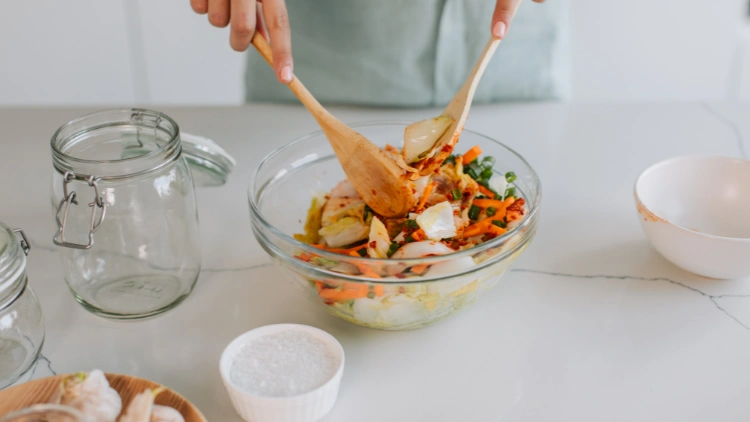
People on a keto diet but like Korean food my wonder if kimchi is keto approved.1
Kimchi is a sour yet spicy Korean dish known for its strong flavor but as usual, keto dieters who eat 30-50* grams of carbs per day must check the nutrition label since many store bought brands and restaurants add sugar and/or starchy vegetables .2
So you can eat kimchi without fear of being kicked out of ketosis, we cover 8 low carb kimchi brands that do not contain sugar, a delicious homemade kimchi recipe, and kimchi’s health benefits.
Kimchi Carbs: Is Kimchi Low Carb?
Keto dieters are in luck and will enjoy the answer to is kimchi low in carbs!
Kimchi is in fact a low in carb dish, in addition to being low in calorie, and does not skimp out on flavor. Like sauerkraut, it’s made from fermented vegetables and seasonings, which are ingredients that can contain carbohydrates but tend to not spike a person’s blood sugar like refined carbohydrates do.
This is ideal for the keto dieters, who have to ensure their blood sugar stays low to remain in ketosis.
Additionally, Kimchi is recognized for its low calorie content, making it ideal for dieters who feel hopeless and are tired of being fat or struggling with weight loss, and overall it’s a great food for both keto dieters and those aiming to lose weight.
What Are the Total & Net Carbs in Kimchi?
Before getting into the total and net carbohydrates in kimchi, let’s review the difference between total and net carbs in general. Both are important to consider when trying to remain in ketosis.
Total carbohydrates refers to all the carbs in a dish, including generalized carbs, fiber, and sugar content. Net carbs, on the other hand, are a little different.
They take the total amount of carbohydrates and subtract the amount of fiber a food contains. This is because fiber is a non-digestible carbohydrate and gets removed from the body during digestion rather than stored for energy.
When it comes to calculating the total and net carbs of kimchi, the answer might vary. This is because different recipes and brands can use varying ingredients and serving sizes.
But as a generalized estimation, a serving size of one cup of kimchi made primarily from cabbage will result in a total of 3.6 grams of total carbs, and 1.2 grams of net carbs.3
Is Kimchi Suitable for Keto? Can You Eat Kimchi on a Keto Diet?
In general, the answer is yes, Kimchi is keto-friendly! It is a delicious and keto safe Korean dish that is low in carbohydrates and high in nutritional value. Due to its low number of total and net carbohydrate content, kimchi should be able to easily fit into a keto dieter’s diet plan.
However, there are a few things keto dieters should still watch out for!
First, kimchi can be enjoyed as a side dish or stand alone meal, but is often added to enhance the flavor of a dish like soups or noodles. If this is the case, keto dieters should consider the carbohydrates in the entire meal rather than just kimchi alone.
Typically rice, noodles, soups that use flour or starch, and kimchi jeon (a type of Korean pancake) will have a significant amount of carbohydrates in them that can put a person well above their 50 grams of carbs allotment per day.
Kimchi ketoers should also consider the ingredients before enjoying this dish. Some kimchi brands may use sugar to help sweeten their product, causing a higher carbohydrate content and blood sugar spike.
As a result, this might take a keto dieter out of ketosis. Keto dieters are encouraged to always consider the ingredients when buying store bought kimchi or using a recipe to ensure they stay compliant with their dietary needs.
Is Kimchi Healthy? What Are the Benefits of Eating Kimchi?
Kimchi is not just keto-friendly; it also offers various health benefits that enhance nutrition and promote overall bodily health.
This is because kimchi is traditionally made from a number of fermented vegetables and zesty spices that combine to not only enhance flavor but also provide many health benefits.

Source: Naim Benjelloun via Pexels4
- Gut Health: Kimchi, like many fermented foods, is great for the gut. It’s high in fiber that aids in a person’s overall digestion and colorectal health, and is researched to have probiotic properties.5
This simply means that it helps to support the growth of good microorganisms in the gut, which is necessary for healthy digestion functioning. - Anti Inflammatory: Kimchi is also considered to have antiinflammatory properties, meaning it helps to decrease the amount of inflammation throughout the body.6 Inflammation can lead to autoimmune responses, various diseases, and even cancer.
- Weight Loss: Kimchi is low in calories and carbohydrates, making it an effective food to help encourage weight loss. Consuming less calories will lead to a larger caloric deficit, or more simply put, burning more calories than consumed, helping to shed fat.
- Heart Healthy: Kimchi has been studied to decrease cholesterol, which in turn decreases a person’s risk of heart disease, cardiac arrest, and stroke.7
Keep in mind, prioritizing healthy eating is arguably the most crucial of the 3 steps to lose weight, so don’t hesitate to include kimchi in your meal plan.
The Best Keto Kimchi Brands (Low Carb Kimchi Brands To Try)
When it comes to the keto-friendliness of kimchi, low carb dieters can’t be too careful. Ketoers should be aware that some kimchi brands have added sugars, making certain products have higher amounts of carbohydrates.
Check out the brands below for a comprehensive list of best kimchi products that are completely keto approved and have no sugar added!
1. Cucumber Fermented Kimchi
This delicious kimchi not only has negative net carbohydrates, but also a wide range of probiotics that aid in the functioning of digestive health. The following probiotics are listed: Lactobacillus Plantarum, Lactobacillus Brevis, Pediococcus Acidilactici, Pediococcus Cerevisiae, and Leuconostoc Mesenteroids.
Ideal for those following extreme diets like the wedding diet, this brand is low in calories and has a negative net carb content.
- Calories: 5 calories
- Total Carbs: 0 grams
- Net Carbs: -1 grams
- Protein: 0 grams
2. Madge’s Food Company Kimchi
This brand offers vegan friendly kimchi that is also gluten free, keto approved, and low in calories. It also comes in traditional and spicy flavors to satisfy every type of craving a keto dieter might have.
- Calories: 8 calories
- Total Carbs: 2 grams
- Net Carbs: 1.5 grams
- Protein: .5 grams
3. Sunja’s Mild White Kimchi
A mild flavor that’s a delicious add to soups and low calorie noodles, or as a stand alone dish. Made with a dash of ginger, this kimchi has a slightly sweeter taste compared to the spicy brands on this list.
- Calories: 15 calories
- Total Carbs: 3 grams
- Net Carbs: 2 grams
- Protein: 0 grams
4. John’s Super Foods Kimchi
A handmade product that has no added sugar, this Kimchi is completely vegan and totally delicious. It’s also ideal
- Calories: 25 calories
- Total Carbs: 4 grams
- Net Carbs: 2 grams
- Protein: 1 gram
5. Simple Truth Organic Kimchi
Not only is this brand keto and sugar free, it’s also organic. Research has found that eating organic foods can correlate with decreased rates of obesity and some diseases such as non-hodgkin’s lymphoma.8
- Calories: 10 calories
- Total Carbs: 2 grams
- Net Carbs: 1 gram
- Protein: 1 gram
6. Mother In Law’s Kimchi
This napa cabbage kimchi is delicious and healthy, with an added benefit of containing no preservatives and using exclusively whole ingredients. This product does contain shrimp, and is therefore not safe for vegan ketoers.
For those curious about whether shrimp is good for weight loss, they’re in luck because this high-protein ingredient boosts the protein content and nutritional value of this kimchi brand.
- Calories: 10 calories
- Total Carbs: 2 grams
- Net Carbs: 2 grams
- Protein: 1 gram
7. Seoul Kimchi’s Spicy Kimchi
This product is a great addition to any Korean style dish. It’s a great level of spice that brings the heat, without being carbs and calories.
- Calories: 15 calories
- Total Carbs: 3 grams
- Net Carbs: 2 grams
- Protein: 1 gram
8. Jongga Napa Cabbage Kimchi
This kimchi has a bit of a kick, which is ideal for those wanting to enjoy a spicy take on a Korean food classic. This is also extremely low in calories, making it a great option for ketoers who are concerned with losing weight.
- Calories: 5 calories
- Total Carbs: 1 gram
- Net Carbs: <1 gram
- Protein: 1 gram
Keto Kimchi Recipes: Mouth Watering Low-Carb Kimchi Recipes
Check out the various recipes below for stand alone keto kimchi, keto kimchi soup or kimchi jjigae, and vegan friendly low sodium keto kimchi. These recipes are dangerously delicious and key for enjoying Korean stapes while sticking to the keto diet plan.

Source: baseimage via Canva.com9
Readers are encouraged to share these recipes with their friends and family who enjoy trying new cuisines, or simply want to cut out the amount of carbs in their diet. Make sure to enjoy!
Standard Keto Low Carb Kimchi
- Step 1) Take 1 lb of cabbage and cut to remove the base. Rinse product.
- Step 2) Dunk cabbage into a bowl of cold water and sprinkle a sizable amount of salt in between the cabbage leaves.
- Step 3) Allow cabbages to be exposed to salt for at least one hour, rotating frequently. Note: for bolder flavor, allow cabbages to sit with salt for multiple hours.
- Step 4) Lightly rinse cabbages in cold water and allow to dry.
- Step 5) In a small pot mix 2 tbsps of sweet rice flour, 1 tbsp of brown sugar, and 2 cups of water. All purpose flour can be used as an alternative in 1:1 ratio. Allow to cook on medium-low for 15 minutes.
- Mixture will bubble.
- Step 6) Remove pot and place in a large mixing bowl with 1 cup of shredded carrots, ½ head of chopped purple cabbage, 5 chopped green onions, 1 chopped purple radish, and ½ cup of chopped sugar snap peas.
- Step 7) Add seasonings: 4 tbsps of minced garlic, 2 tbsps of chopped ginger, ½ cup of fish sauce, ½ cup of red pepper flakes, and ¼ cup of hot sauce of choice. Hot sauce not only supports weight loss but also offers a variety of other health benefits!
- Step 8) Mix ingredients and spread onto cabbage leaves. Place into an air tight container to allow fermentation for a few days before enjoying.
Low Sodium, Vegan Friendly, Keto Kimchi
For a low sodium, vegan approved version simply use the above recipe with a couple of minor adjustments.
First, make sure to use less salt during the cabbage preparation stage and allow cabbage to dry for a longer period of time. Additionally, low sodium dieters should opt to use a low sodium hot sauce with the recipe.
Finally, vegans should exchange the fish oil for a mixture of half sesame seed oil and water. Additional hot sauce can be used for a spicier kimchi flavor.
Kimchi Jjigae: The Korean Kimchi Soup
This recipe can use either kimchi recipes above, or store bought kimchi. This makes roughly four servings of Kimchi to enjoy.
- Step 1) Chop and saute 1 small onion in oil of choice in a medium to large pot.
- Step 2) Season 1 lb of meat or meat alternative of choice and pan fry.
- Step 3) Add 2 cups of kimchi, 3 green onions chopped, 1 teaspoon of hot pepper paste, and 1 lbs of meat or meat alternative of choice to pot with onion. Mix ingredients.
- Step 4) Add seasonings to taste or 1 teaspoon of salt, 1 teaspoon of fresh ground pepper, 2 dashes of red pepper flakes, 1 teaspoon of ginger. Mix and allow vegetables and meat to soak flavor for ~5 minutes.
- Pinch of sugar optional to decrease acidity.
- Step 5) Add approximately 3 cups of preferred meat or vegetable broth and allow to cook on low for 1 hour while stirring regularly.
- Step 6) Add additional seasonings to taste such as salt, pepper, and garlic to taste.
- Step 7) Enjoy over low carb noodles or rice, or eat as a stand alone stew.
Overall kimchi is a low calorie, low carb dish that has a number of health benefits when added into a diet. Diets should keep in mind that kimchi is keto-friendly and should aim to try adding this food in their diet plan by picking up any of the keto approved kimchi brands or trying the keto friendly kimchi recipes discussed above.
Frequently Asked Questions
Is Kimchi Keto When Store Bought?
Kimchi is typically keto safe due to its low carb nature. However, keto dieters should always double check the nutritional label and ingredients to ensure that a product doesn’t contain sugar or an excess of carbs before purchasing.
Is Kimchi Good for Weight Loss?
Kimchi can be a great food to help with weight loss, especially weight loss for beginners, because it is so low in calories. It’s also a good digestive aid, which can be known to help further increase weight loss, decrease obesity risk, and boost metabolism.
References
1Anusak Rojpeetipongsakorn. “Partial view of Women wearing Korean Hanbok dress eating Kimchi kimgee isolate on white background.” Canva. Accessed 22 April 2023. <https://www.canva.com/photos/MAEX6W3KMmA-partial-view-of-women-wearing-korean-hanbok-dress-eating-kimchi-kimgee-isolate-on-white-background-/>
2Harvard T. H. Chan School of Public Health. 2022. Ketogenic Diet For Weight Loss. Harvard. Web. Retrieved on 13 March 2023. <https://www.hsph.harvard.edu/nutritionsource/healthy-weight/diet-reviews/ketogenic-diet/#:~:text=The%20ketogenic%20diet%20typically%20reduces,and%2010%2D20%25%20protein>
3Food Data Central of National Agricultural Library. 2019. Food Data Cabbage, Kimchi. U.S. Department of Agriculture. Web. Retrieved on 13 March 2023. <https://fdc.nal.usda.gov/fdc-app.html#/food-details/170392/nutrients>
4Naim Benjelloun. “Kimchi Food in White and Blue Ramekin Bowl.” Canva. Accessed 22 April 2023. <https://www.canva.com/photos/MADyR4k1skM-kimchi-food-in-white-and-blue-ramekin-bowl/>
5Park, K. Y., Jeong, J. K., Lee, Y. E., & Daily, J. W., 3rd (2014). Health benefits of kimchi (Korean fermented vegetables) as a probiotic food. Journal of medicinal food, 17(1), 6–20. <https://doi.org/10.1089/jmf.2013.3083>
6Kim, H. J., Noh, J. S., & Song, Y. O. (2018). Beneficial Effects of Kimchi, a Korean Fermented Vegetable Food, on Pathophysiological Factors Related to Atherosclerosis. Journal of medicinal food, 21(2), 127–135. <https://doi.org/10.1089/jmf.2017.3946>
7Choi, I. H., Noh, J. S., Han, J. S., Kim, H. J., Han, E. S., & Song, Y. O. (2013). Kimchi, a fermented vegetable, improves serum lipid profiles in healthy young adults: randomized clinical trial. Journal of medicinal food, 16(3), 223–229. <https://doi.org/10.1089/jmf.2012.2563>
8Glibowski P. (2020). Organic food and health. Roczniki Panstwowego Zakladu Higieny, 71(2), 131–136. <https://doi.org/10.32394/rpzh.2020.0110>
9baseimage. “Woman Making Homemade Kimchi.” Canva. Accessed 22 April 2023. <https://www.canva.com/photos/MAFEGz5_o24-woman-making-homemade-kimchi/>